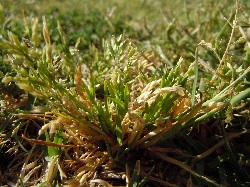ManageSafe
Least-Toxic Control of Annual Bluegrass Choose a different pests

|
Factsheet: Read Your Weeds, Maintaining Sustainable Lawns and Landscapes
Identification
Pest type: Plants
In-depth information:
According to UC IPM: "Annual bluegrass is a cool-season grass weed that starts germinating in late summer or fall as soil temperatures fall below 70°F. It continues to germinate throughout winter, allowing several flushes of germination at any one site throughout the season. Annual bluegrass grows 6 to 8 inches high when left unmowed. It has light green flattened stems that are bent at the base and often rooted at the lower stem joint. Leaf blades are often crinkled part way down and vary from 1 to 3 inches long with typical Poa boat-shaped leaf tips. The inflorescence (flowering structure) has branched seed clusters (panicles) that are 1 to 4 inches long. Seed clusters, also called seed heads, can form as soon as plants are six weeks old; although this can occur from early fall through early summer, most seed heads are formed in spring."
Is it a problem?
Weeds may cause allergies or lead to skin rash on contact. Most weeds are simply a nuisance because they are considered unappealing in a lawn. A few weeds should be tolerated, but weed infestations that overtake turf grass are signs of unhealthy soil.
Pest prevention practices
Foster natural resilience
In-depth information:
A primary method of control is preventing new infestations. Weeds can be easily spread between homes and other sites when seeds contaminate equipment such as mowers, string trimmers and aerifiers. You can avoid spreading weeds from place to place by being sure to properly clean equipment after use in an infected site.
Having healthy soil, using at least two native turfgrasses, proper watering, and a sensible landscape design can all help your lawn ecosystem develop a natural resistance to weeds. Indeed, annual bluegrass and other weeds in your lawns are often a sign that the balance of your soils are off. Excessive watering and fertility tend to promote annual bluegrass growth, along with soil compaction, so aerating the lawn, using proper watering techniques and testing your soil can help you manage weeds in your lawn.
Monitoring and record-keeping
Keep an eye out in your lawn for areas where annual bluegrass begins to take root. Once a few annual bluegrass plants become established in turf or ornamental areas, it can spread very quickly due to rapid seed production.
If you find a solitary plant of annual bluegrass, you can prevent a large outbreak by removing the plant before seed production begins. You can hand pull the weeds or hoe frequently in order to mitigate the spread of these weeds. Certain places need frequent attention, such as open areas where old annual bluegrass weeds were previously removed.
Non-chemical and mechanical controls
Flame treatment
Boiling water
Mow lawn above 2 inches
Aerate soils
Proper watering
Dethatching
Handpick and destroy
In-depth information:
According to UC IPM:
"One should use deep and infrequent irrigation to discourage the development of shallow-rooted annual bluegrass. Try withholding water until the desirable turf is beginning to show drought stress, rather than keeping the surface moist. Avoid fertilization and don’t aerate turf during the peak of annual bluegrass germination. Also, avoid cultural practices as well as use patterns that tend to promote soil compaction.
Hand removal of solitary plants will save time and money in the long run. Cultivation or hand hoeing, although possible under some circumstances, generally isn’t useful unless continued throughout the germination period because seed that is buried in the soil is brought to the surface where it germinates.
Mulching with landscape fabrics can be effective if the fabric is overlapped so no light is allowed to reach the soil. Plant-derived products (i.e., organic mulches) or rock can be used over the top of the fabrics.
When used alone, plant-derived products should be 2 to 3 inches thick, depending on the coarseness of the mulch. Finer materials can be less thick than coarser ones. If seeds of annual bluegrass get into the mulch, they can germinate and establish, just as if they were in soil. In these cases annual bluegrass plants can be easily removed by hand or with a hoe. Mulch thickness will need to be replenished periodically to maintain cover and eliminate light penetration to the soil."
Biological controls
Goats are herbivorous foragers that are very effective at controlling weeds since grass is their least desirable food choice. They can be especially effective for roadside management, along railroad tracks, parks, forests, etc. Many people now make a living by contracting themselves and their herd out for weed control around the nation.
Least-toxic chemical options as a last resort
- Horticultural vinegar, or acetic acid, is also effective at killing certain weeds. Avoid spraying other green vegetation, such as turfgrass, since this is a nonselective plant killer.
- Herbicidal soaps are highly refined soaps that can penetrate the waxy coating on plant leaves, causing them to dry out.
Chemicals to Avoid
Look at your product labels and try to avoid products containing those chemicals listed below:
(A = acute health effects, C = chronic health effects, SW = surface water contaminant, GW = ground water contaminant, W = wildlife poison, B = bee poison, LT = long-range transport)
|
Bensulide Diquat Dibromide | Dithiopyr Glyphosate | Trifluralin |
Social Media
See what other folks are saying about this, and let us know what works for you.
Click the post above to view and comment on Facebook, or comment directly on this site below.








